Eugene M. Frandzen painted the covers of The Lone Eagle from its first issue in September 1933 until the June 1937 issue when Rudolph Belarski took over with the August issue of that year. At the start of the run, Frandzen painted covers of general air action much like his Sky Fighters covers. Here, for the November 1933 cover, Frandzen gives us the classic match-up—the Nieuport Type 27 vs. the Fokker D7!
The Story of the Cover
THE ships pictured on this 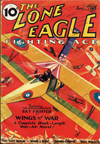 month’s cover are the Nieuport Type 27 and the Fokker D7.
month’s cover are the Nieuport Type 27 and the Fokker D7.
The Nieuport Type 27 was a single-seater biplane manufactured by Soc Anonyme des Etablissements Nieuport. The firm was established by Edouard de Nieuport in 1910.
When the War broke out they were ready with a fighting machine, the small two-seater Nieuport. The Type 27 was a real fighting craft of later war years, 1916 and 1917 to be exact. It had high speed and plenty of quickness in action compared to the early Nieuports, but it was closely patterned after the early machines.

The majority of Nieuports were the planes which were noted for their “V” strut design. The Germans swiped the “V” strut idea for two of their best fighting machines, the famous Albatros and Pfalz. The Nieuport 27 had a neat streamlined fuselage. It carried a Vickers synchronized with the airscrew. The ship was shot along at 105 m.p.h. by a 120 h.p. Le Rhone engine. Bishop, the British Ace flew Nieuports and swore by them. Lufbery, the American, was flying one when he fell in a spin to his death.
The Nieuport flashing into the cover to go to the assistance of his buddy in another Nieuport, is not alone. Behind him is his gang. He is waving them to follow him into the fight. In a few seconds hell will break loose around the Fokkers ganging the lone Allied plane.
Ganging was a great game in the Big War. Both sides did it, but the Germans deliberately waited for such situations and often shunned a sporting proposition of an equal scrap. The Yanks, French and English didn’t go out of their way to run down a lone foe. But, of course, if one happened to flounder into a mess of Allied planes he wasn’t handed a bouquet and told to run along home.
If a quick burst from the nearest Fokker doesn’t smash the zig-zagging Nieuport, its pilot has an even break of getting out with a whole skin. It’s a matter of seconds till it will be “Everybody for himself.”
The Fokker D7 was the most popular of Fokkcr’s many models. It deserved this popularity for its fine fighting qualities. Its unusual features were the entire metal inner construction of the fuselage and the interplane bracing members, the thick wings, and the absence of external bracing wires between the wings. These were radical changes in airplane design, but they worked. There were one hundred and sixty horses neighing in its ugly, blunt nose. They pulled it along at 110 m.p.h. at 10,000 feet. The big Mercedes engine was a heavy load so the D7 was a little nose heavy, but it had enormous power with the ability to hang on the prop in a position of 45 degrees while pushing forward. This was a life-saver for many German fliers.
The Nieuport and the Fokker both blasted themselves a niche in the Hall of Fame of World War ships. Both were husky war horses. They gave real speed, and they held together, which is more than can be said of many of the War’s flying coffins.

The Lone Eagle, November 1933 by Eugene M. Frandzen
(The Story of The Cover Page)
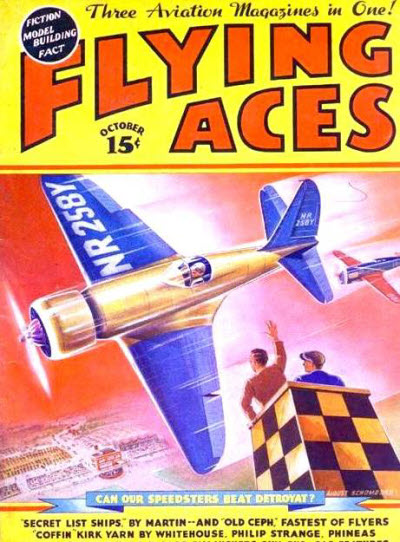 That sound can only mean one thing—that Bachelor of Artifice, Knight of Calamity and an alumnus of Doctor Merlin’s Camelot College for Conjurors is back to vex not only the Germans, but the Americans—the Ninth Pursuit Squadron in particular—as well. Yes it’s the marvel from Boonetown, Iowa himself—Lieutenant Phineas Pinkham!
That sound can only mean one thing—that Bachelor of Artifice, Knight of Calamity and an alumnus of Doctor Merlin’s Camelot College for Conjurors is back to vex not only the Germans, but the Americans—the Ninth Pursuit Squadron in particular—as well. Yes it’s the marvel from Boonetown, Iowa himself—Lieutenant Phineas Pinkham! 





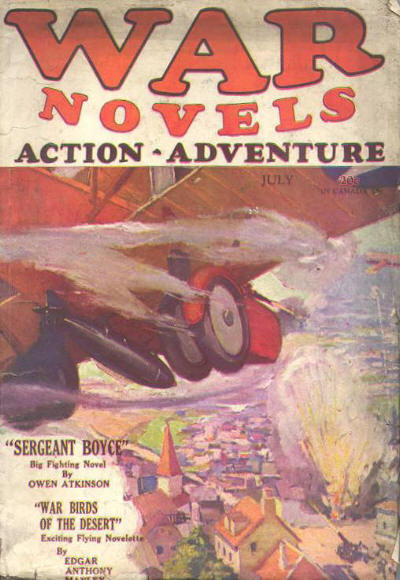 a story from the pen of C.M. Miller! Miller is known to Age of Aces readers as the author behind
a story from the pen of C.M. Miller! Miller is known to Age of Aces readers as the author behind 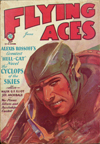

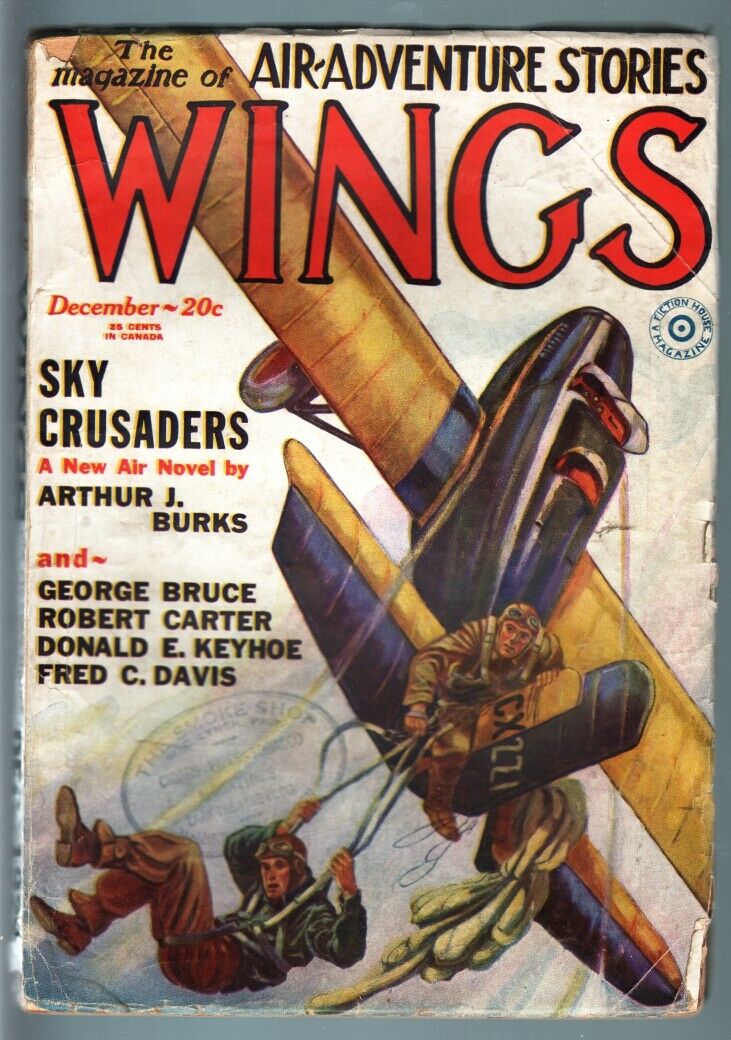 a story from the pen of Donald E. Keyhoe—in fact, I believe it is his first aviation story he had in the pulps! More soap opera than dashing wartime aviation thriller, Keyhoe tells the story of Harvey Masters, Dizzy Jim Boyd, and the girl unwittingly caught between them! The strangest part is that nobody ever suspected the truth about Dizzy Jim Boyd, though there was a lot of guessing when he first showed up at Western Airways Field, until the day when Harvey Masters came through and stopped for gas. . .
a story from the pen of Donald E. Keyhoe—in fact, I believe it is his first aviation story he had in the pulps! More soap opera than dashing wartime aviation thriller, Keyhoe tells the story of Harvey Masters, Dizzy Jim Boyd, and the girl unwittingly caught between them! The strangest part is that nobody ever suspected the truth about Dizzy Jim Boyd, though there was a lot of guessing when he first showed up at Western Airways Field, until the day when Harvey Masters came through and stopped for gas. . . 

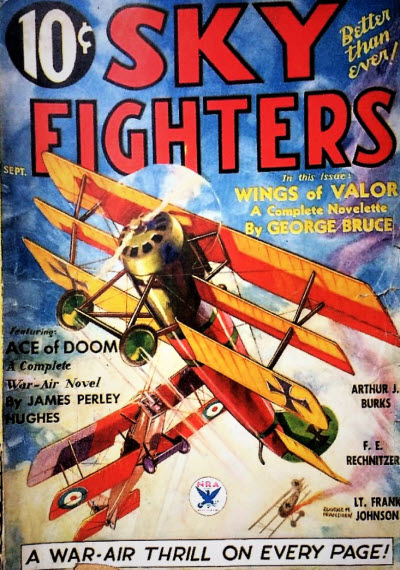 a story from the pen of a prolific pulp author—F.E. Rechnitzer. Tip Hunley was a forgetful sort—he would even forget his commanding officer’s direct orders. The result of which found him grounded the night before his squadron was to set to bomb the ammunition dump at Roulents early the next morning. However, he neglected to remember that he had been grounded when he took a Sopwith Camel up and took on the Roulents dump all on his own! Surely an unforgettable story he could one day tell his grandkids! From the pages of the September 1934 issue of Sky Fighters, it’s F.E. Rechnitzer’s “Solo Show!”
a story from the pen of a prolific pulp author—F.E. Rechnitzer. Tip Hunley was a forgetful sort—he would even forget his commanding officer’s direct orders. The result of which found him grounded the night before his squadron was to set to bomb the ammunition dump at Roulents early the next morning. However, he neglected to remember that he had been grounded when he took a Sopwith Camel up and took on the Roulents dump all on his own! Surely an unforgettable story he could one day tell his grandkids! From the pages of the September 1934 issue of Sky Fighters, it’s F.E. Rechnitzer’s “Solo Show!”


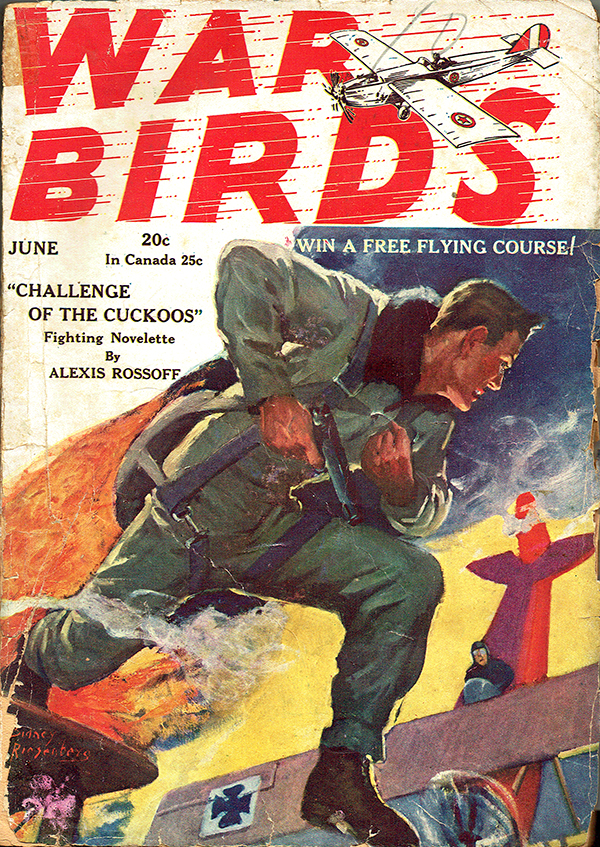 a story from the pen of a prolific pulp author O.B. Myers! Myers was a pilot himself, flying with the 147th Aero Squadron and carrying two credited victories and awarded the
a story from the pen of a prolific pulp author O.B. Myers! Myers was a pilot himself, flying with the 147th Aero Squadron and carrying two credited victories and awarded the 
